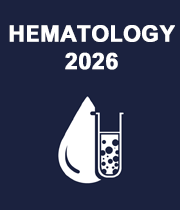Title : Antioxidants as modulators of stored blood and its components
Abstract:
Blood banking brings the potentially life-saving benefits to the patients who require transfusion. Transfusion medicine has undergone advancements such as component therapy, where cellular components including, packed erythrocytes & platelet concentrates are transfused. Erythrocytes can be stored up to 35 days in CPDA-1 and 42 days in AS-7 (additive solution-7) at 4?C. Platelets are stored for 3-5 days in plasma at 22-24?C. Blood components exhibit morphological, biochemical, and physiological changes during storage collectively referred as “storage lesions”, which affect the survival and optimal function of transfused components. Oxidative Stress (OS) is the primary cause of storage lesions in blood and its components. The accumulation of reactive species during storage is associated with the impairment of antioxidant defenses and oxidation of lipids and proteins.
Antioxidants can scavenge free radicals, reduce oxidative stress and maintain cellular redox balance. Hence, storage solutions enriched with antioxidants can counteract oxidative damage and enhance antioxidant defenses. Therefore, antioxidants as additives could be safe and effective alternatives to improve the efficacy of stored blood components.
The continual modulations occurring in stored erythrocytes and platelets with antioxidants as additives have been investigated. Firstly, Vitamin C (10, 30 & 60 mM), L-Carnitine (10, 30 & 60 mM), Curcumin (10, 30 & 60 mM) in CPDA-1 have been employed as single antioxidants during 35 days of erythrocyte storage. Vitamin C protected the erythrocytes from oxidative damage and increased protein sulfhydryls levels. L-Carnitine maintained hemoglobin and sulfhydryls throughout the storage. Curcumin maintained hemoglobin and modulated antioxidant enzymes throughout storage. Erythrocyte storage in AS-7 (FDA approved) have been further explored with combinations of Vitamin C & L-Carnitine (both at 10 mM), Vitamin C & Vitamin E (10 mM & 2 mM), and Vitamin C & N-acetyl cysteine (10 mM & 0.5mM). These combinations have been effective in enhancing antioxidant defenses and attenuating oxidative damage. Cell aging as one of the significant factors in banking has also been studied, where responses of young and old erythrocytes have been investigated. OS levels were found to be higher in old cells than young cells. The Dr. Vani Rajashekaraiah Abstract as per Template oxidative changes occurred in young cells from day 25, whereas in old cells from day 5 itself. Young erythrocytes could endure OS more efficiently than old erythrocytes.
Secondly, Platelets were banked in additive solutions (PAS) as a substitute for plasma to extend storage period. The alterations in platelets stored with antioxidant additives such as L-Carnitine (10, 50 &100 mM), Coumaric acid (10, 50 &100 mM), Carica papaya/CaripillTM (50 & 100 µg/ml) and Cassia tora (50 & 100 µg/ml) have been analysed. These antioxidant additives have been effective in diminishing oxidative stress, thereby improving the efficacy of platelets. Oxidative stress in platelets stored in commercially available PASs such as, SSP+ and PAS-G have been determined, and these additive solutions have augmented antioxidant enzymes and platelet functions during 7 days of storage. These findings lay foundations towards development of effective storage solutions and better blood banking practices.
Audience Takeaway:
- Audience will gain insights into the main factors leading to storage lesion and the effects of antioxidant additives in storage solutions with reference to erythrocytes and platelets.
- Audience can employ different markers of storage lesion to assess banked blood.
- This basic research lays foundations towards improving the efficacy of stored blood components and better blood banking.
- Other benefits. Development of effective storage solutions.



